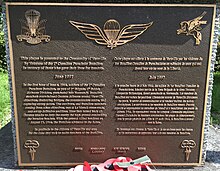
Back 1er bataillon parachutiste (Canada) French 1e Parachutistenbataljon (Canada) Dutch 1. padalski bataljon (Kanadska kopenska vojska) Slovenian
| 1st Canadian Parachute Battalion | |
|---|---|
 Plaque in Varagille commemorating the battalion. The battalion's cap badge is on the top left corrner | |
| Active | 1942–1945 |
| Country | Canada |
| Branch | Canadian Army |
| Type | Airborne forces |
| Role | Parachute infantry |
| Size | Battalion |
| Part of | 3rd Parachute Brigade (United Kingdom) |
| Nickname(s) | 1 Can Para |
| Colors | Maroon beret |
| Engagements | |
| Battle honours |
|
| Commanders | |
| Notable commanders | H.D. Proctor, July 1st, 1942–Sept. 7, 1942 G.F.P. Bradbrooke, 1942–1944 Jeff Nicklin 1944–1945 |
The 1st Canadian Parachute Battalion was an airborne infantry battalion of the Canadian Army formed in July 1942 during the Second World War; it served in North West Europe, Landing in Normandy during Operation Tonga, in conjunction with the D-Day landings of 6 June 1944 and in the airborne assault crossing of the River Rhine, Operation Varsity, in March 1945. After the end of hostilities in Europe, the battalion was returned to Canada where it was disbanded on 30 September 1945.[2]
By the end of the war the battalion had gained a remarkable reputation: they never failed to complete a mission, and they never gave up an objective once taken. They are the only Canadians to participate in the Battle of the Bulge and had advanced deeper than any other Canadian unit into enemy territory.[3] Despite being a Canadian Army formation, it was assigned to the British 3rd Parachute Brigade, a British Army formation, which was itself assigned to the British 6th Airborne Division.
- ^ Eagle Sgt. "Allied Airborne Headquarters - CANADIAN AIRBORNE". homeusers.brutele.be. Retrieved 2014-07-28.
- ^ "www.canadiansoldiers.com". www.canadiansoldiers.com. Retrieved 2022-01-19.
- ^ Horn, Bernd. Bastard Sons, and Examination of Canada's Airborne Experience 1942–1995. Vanwell Publishing Limited, 2001
© MMXXIII Rich X Search. We shall prevail. All rights reserved. Rich X Search